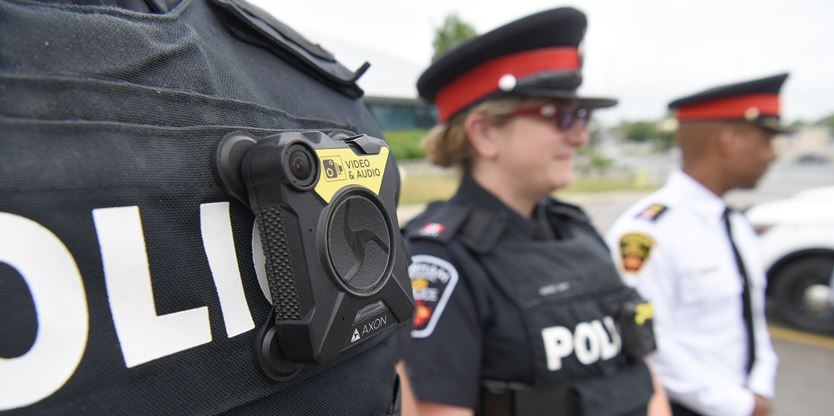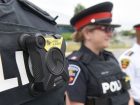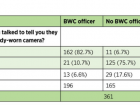
Features
Opinion
Technology
The effect of body-worn cameras on public perceptions of police: A Canadian study
Body-worn cameras (BWCs) are a technology being explored by police services in Canada and around the world. The push for frontline officers to wear BWCs is partly about improving public concerns with police accountability, based on the assumption that BWCs will discourage and/or hold officers accountable for misconduct (especially any possible mistreatment of citizens).
April 22, 2019 By Alana Saulnier

This logic suggests BWCs improve public perceptions of police by improving officer behaviour. However, it’s possible BWCs affect public perceptions of police without impacting officer behaviour.
Does the simple presence of a BWC actually affect public perceptions of an interaction with an officer? A new Canadian study provides an answer. The experiment demonstrates that in a police-citizen interaction where officers were assigned to either wear or not wear BWCs (but their behaviour was very consistent regardless), citizens reported more positive perceptions of police when they interacted with an officer wearing a BWC.
The study
From Nov. 20 to Dec. 8, 2018, Lakehead University researchers conducted an experiment alongside the Festive R.I.D.E. line with the Durham Regional Police Service (DRPS), located east of Toronto. (The Ontario R.I.D.E. program is a police initiative designed to reduce impaired driving. R.I.D.E. lines are a surprise checkpoint set up to stop motorists for a brief interview to check for intoxication.)
DRPS has been researching the cost and value of a BWC program since 2014, says Sgt. Jason Bagg, the project manager for DRPS’s Body-Worn Camera Pilot Project.
“For a body-worn camera program to be viable for us, the benefits of the technology must outweigh the costs,” he says. “Our partnership with Dr. Saulnier is supporting our evaluation of the technology during our pilot deployment. This evaluation will include a cost-benefit analysis in support of evidence-based decision-making. This community perceptions study, done in co-operation with our Festive R.I.D.E. team, presents some scientific evidence of the positive benefits of body-worn cameras as they relate to police-community interactions.”
The R.I.D.E. line offered a short, standardized interaction, ideal for an experiment. Here, officer behaviour was held relatively constant, whether they were wearing a BWC or not.
For the 15 shifts during this time, officers wore BWCs for eight shifts and did not wear them for the remaining seven. All officers involved made the same approximately 10-second introduction to motorists stopped in the R.I.D.E. line. However, officers wearing the cameras also informed citizens that they were wearing a BWC and that the device was recording.
Survey invitations were handed out to 3,636 motorists following their successful completion of the R.I.D.E. line check. The survey included questions about the citizen’s R.I.D.E. line experience, as well as their opinions of police in general.
A total of 361 surveys were completed online and 287 met a level suitable for analysis. In particular, the experiment tracked whether motorists interacted with a BWC-wearing officer or not. Survey respondents who did not accurately recollect the presence of a BWC were excluded from the analyses (see Table 1 below or here).
Results
Persons who interacted with an officer wearing a BWC felt more positively about all of the outcomes measured in the survey. However, key findings are that persons interacting with officers wearing a BWC (compared to officers not wearing BWCs) had significantly more positive perceptions of…
• officer politeness during the R.I.D.E. interaction
• officer fairness during the R.I.D.E. interaction
• DRPS performance in general (i.e., solving crime, dealing with problems, keeping order)
• confidence in police in general
• police fairness in general
• support for police use of BWCs
Due to the highly standardized nature of the interactions, these results do not suggest that public perceptions were more positive because officer behaviour was any different, but simply that the interaction was perceived more favourably as a result of the camera’s presence.
Discussion and conclusion
These results provide evidence that wearing and declaring a BWC…
1. positively affected public perceptions of specific encounters with DRPS officers
2. positively affected public perceptions of police more broadly
3. positively affected public support for BWCs
While it cannot be discounted that the BWC might have subtly influenced officer behaviour, the study suggests public attitudes might be influenced positively by the mere presence of BWCs, apart from impacts BWCs might have on officer behaviour.
Only two other known studies have used experiments to assess actual effects of BWCs on public perceptions of police following a police-citizen interaction. One study reported participants’ satisfaction with police was improved by BWCs (Urban Institute, 2017), while the other concludes that BWCs had no impact on public perceptions (Police Executive Research Forum, 2017).
Neither of these projects were conducted in Canada, and the DRPS experiment is stronger in important ways. For example, it focuses only on a single type of police-citizen interaction, using research assistants to observe consistency in officer behaviour, and it keeps track of which citizens interacted with an officer wearing a BWC. Bearing these differences in mind, comparing the findings of the DRPS study to these previous studies reveals noteworthy details nonetheless.
First, the DRPS findings complement the Urban Institute’s experiment and the results of both studies suggest declaring the presence of a BWC may be important to achieving positive impacts of BWCs on public perceptions.
Alternatively, the DRPS findings run contrary to those from the Police Executive Research Forum (PERF), which did not demonstrate an impact on public perceptions from BWCs. PERF explains these results by suggesting BWCs may be less influential on public sentiments when community perceptions of police are already highly favourable. However, DRPS enjoys very positive community perceptions (91 per cent to 96 per cent confidence in recent online and phone surveys, respectively, according to the service’s 2017 report). As such, the DRPS study demonstrates that even with favourable community-police relations, BWC presence can still positively impact public perceptions of law enforcement.
Why do these results matter?
Public perceptions of police are important to understand because they impact public interactions with police. When citizens evaluate police more positively, they are more likely to comply with these legal authorities (Bradford, Jackson & Hough, 2013; Sunshine & Tyler, 2003). There has been speculation that public perceptions of police will be enhanced through the use of BWCs, and the DRPS experiment provides actual evidence of this outcome. However, this study urges consideration of how the mere presence of the BWC affects public perceptions, apart from influences on officer behaviour.
“Improving the confidence of the public with respect to the police and their interactions is a goal of most police services in Canada,” adds Vishal Dhir, the managing director for Canada and Latin America for Axon, the company providing the devices for the study. “Having evidence-based research that shows positive results for officer interactions and police confidence is very exciting; I’m looking forward to seeing how Dr. Saulnier’s work will impact how Canadian departments can use body cameras to help combat impaired driving and improving public trust.”
Acknowledgment
This research was made possible with the co-operation and support of DRPS and Lakehead University research assistants. A sincere thank you is extended to the service, officers and students for their contributions to the production of evidence-based police policy.
References
Bradford, B., Jackson, J. & Hough, M. 2013. Police futures and legitimacy: redefining “good policing”. In J. Brown, ed. The Future of Policing. Oxon: Routledge, 79-99.
DRPS [Campbell, E.]. 2017. DRPS 2017 body-worn cameras public survey. Internal report.
Police Executive Research Forum [PERF] [Goodison, S. & Wilson, T.]. 2017. Citizen perceptions of body worn cameras: A randomized controlled trial. Retrieved from https://perf.memberclicks.net/assets/bodyworncameraperceptions.pdf.
Sunshine, J. & Tyler, T. 2003. The role of procedural justice and legitimacy in shaping public support for policing. Law & Society Review, 37(3): 513-548.
Urban Institute [McClure, D., La Vigne, N., Lynch, M., Golian, L., Lawrence, D. & Malm, A.].
2017. How body cameras affect community members’ perceptions of police: Results from a randomized controlled trial of one agency’s pilot. Justice Policy Center. Retrieved from www.urban.org/sites/default/files/publication/91331/2001307-how-body-cameras-affect-community-members-perceptions-of-police—1.pdf.
Alana Saulnier, PhD, is an Assistant Professor and Criminology Program Co-ordinator at Lakehead University in Orillia, Ont.
Print this page

